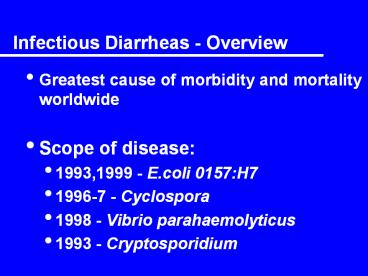Infectious Diarrheas - Overview - PowerPoint PPT Presentation
Title:
Infectious Diarrheas - Overview
Description:
1998 - Vibrio parahaemolyticus 1993 - Cryptosporidium GI Infectious ... secretory Vibrio cholera, enterotoxigenic E.coli Inflammatory ... – PowerPoint PPT presentation
Number of Views:445
Avg rating:3.0/5.0
Title: Infectious Diarrheas - Overview
1
Infectious Diarrheas - Overview
- Greatest cause of morbidity and mortality
worldwide - Scope of disease
- 1993,1999 - E.coli 0157H7
- 1996-7 - Cyclospora
- 1998 - Vibrio parahaemolyticus
- 1993 - Cryptosporidium
2
GI Infectious Factors increasing risk
- Food-borne
- Travelers
- Institutionalized settings
3
GI Infections Epidemiologic Factors
- WHO you are
- WHERE you are
- WHEN it occurs
4
GI Infections - Transmission
- Fecal oral route
- Can include sexual transmission
- Infectious inoculum
5
GI Infections Host Defense Mechanisms
- Hygiene
- Gastric acidity
- GI motility
- Normal flora
- Non-specific intestinal immunity
- Mucosal associated antibody production
6
GI Infections Microbial Virulence Factors
- Adhesion
- Toxins
- Enterotoxins
- Cytotoxins
- Neurotoxins
- Invasiveness
7
Infectious Diarrheas Pathophysiologic Mechanisms
- Enterotoxin-mediated - secretory
- Vibrio cholera, enterotoxigenic E.coli
- Inflammatory
- cytotoxin-mediated
- Systemic syndromes
8
Infectious Diarrheas Enterotoxigenic E. coli
- (ETEC)
- Adherence
- Toxins
- Heat labile toxin
- Heat stable toxin
9
Infectious Diarrheas Clinical
SyndromeEnterotoxin-mediated Gastroenteritis
- History Risk Factors
- NO fever, systemic findings
- Profuse watery stools
- NO fecal WBCs
- Small bowel
- Often normal gross exam and histopathology
10
Infectious Diarrheas Pathophysiologic
Mechanisms
- Enterotoxin-mediated secretory
- Inflammatory cytotoxin-mediated
- Shigella, shiga-toxin producing E. coli,
Clostridium difficile - Systemic syndromes
11
Infectious Diarrheas Shiga-toxin producing E.
coli (STEC)
- Food and water borne illness with high morbidity
and mortality - Association with Hemolytic Uremic Syndrome (HUS)
and Thrombotic Thrombocytopenic Purpura (TTP) - 25 hospitalized
- 6 (15 children) develop HUS
- 1 fatal
- Shiga toxin production
12
Infectious Diarrheas Shiga Toxin
- AB Toxin
- Recognizes gal?-1,4-gal residues
- Blocks protein synthesis
- Role in Hemolytic Uremic Syndrome (HUS) and
Thrombotic Thrombocytopenic Purpura (TTP)
13
Infectious Diarrheas Clinical
SyndromeInflammatory/Cytotoxin-mediated
gastroenteritis
- History
- Dysentery
- Risk Factors
- Physical Exam/Labs
- Fever, abdominal pain
- Volume loss less prominent
- Leukocytosis
- WBCs and RBCs in stool
- () toxin in stools
14
Infectious Diarrheas Pathology
- Inflammatory
- Cytotoxin-mediated gastroenteritis
- Colon, large bowel
- Limited to GI mucosa
- Erosions, ulcerations
15
GI Infections Pathophysiologic Mechanisms
- Enterotoxin-mediated - secretory
- Inflammatory
- cytotoxin-mediated
- Systemic syndromes
- Salmonella, Yersinia
16
GI Infections Salmonella spp.
- Typhoid fever, gastroenteritis
- Typhi vs. non-typhi
17
GI Infections Salmonella Pathogenesis
- Uptake by cells
- Multiplication in mononuclear cells
- Hematogenous dissemination
- Replication in liver and spleen
- Excretion in bile
- Secondary bacteremia and entry into gut lumen
18
GI Infections Salmonella Virulence Factors
- Invasins SPI-1 - Type III secretion system
- Intracellular pathogen
- Resistance to defensins
- Survival in phagocytes - phoP/phoQ
- Resistance to oxygen radicals
- Resistance to low pH
19
GI Infections Salmonella Virulence Factors
- Systemic dissemination SPI-2
(Type III secretion system) - Resistance to complement-mediated cytotoxicity
- Long O antigen
- rck outer membrane protein
- Capsular polysaccharide Vi antigen
20
GI InfectionsSalmonella Clinical Syndrome
- History Risk Factors
- Systemic illness
Diarrhea often not prominent - Laboratory
- Anemia, leukopenia, elevated liver function
studies - () Blood cultures
- () Stool cultures
21
Infectious Diarrheas Viral
- Rotavirus
- Caliciviruses/Norwalk-like viruses
- 40 cases infectious diarrhea in U.S.
- No toxin identified but produce histologic
changes and alterations in fluid/electrolyte
absorption/secretion - Small bowel no fecal WBCs
22
Infectious Diarrheas - Diagnosis
- History
- Risk factors
- ? Systemic symptoms
- Character of stool
- Physical Exam
- Direct stool exam
- Gross description
- Fecal leukocytes
- Exam for parasites
23
Infectious Diarrheas - Diagnosis
- Immunoassays for toxins, viruses
- Stool culture
- May be of limited use for E. coli
- Not routinely performed for viruses
- Blood culture
- Only useful for systemic infections e.g.
Salmonella
24
Infectious Diarrheas - Treatment
- Fluid and electrolyte replacement
- Antibiotic therapy
- Contra-indication?
Shiga-toxin producing E. coli - Epidemiologic considerations
25
Infectious Diarrheas - Prevention
- Adequate water, sanitation facilities
- Hygiene
- Food handling
- Vaccines



























![STN 125011 Tositumomab Therapeutic Regimen (TTR) [tositumomab plus I-131 tositumomab] PowerPoint PPT Presentation](https://s3.amazonaws.com/images.powershow.com/7258373.th0.jpg?_=20151013059)



